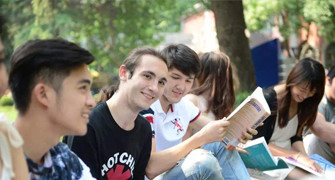In the afternoon of May 8, Professor Zou Wei from Economics and Management School of Wuhan University was invited by Ying Yong, Secretary of the provincial Party Committee, and Wang Xiaodong, deputy Secretary of the provincial Party Committee and governor of the province, to participate in a symposium of experts and scholars with seven other scholars to offer advice and suggestions for the province's revitalization after the epidemic and the preparation of the "14th Five-Year Plan".
Zou Wei, Professor and Doctoral Supervisor, Economics and Management School of Wuhan University, Member of the Standing Committee of the Chinese People's Political Consultative Conference, Hubei Provincial People's Government, and Member of the Advisory Committee of the Wuhan Provincial People's Political Consultative Conference.
During the seminar, Professor Zou Wei spoke on the topic of "Seeking Opportunities in Crisis, Two-Wheel Drive, and Planning a New Pattern of Hubei's Economic Development".(The following is the content of Prof. Zou Wei's speech.)
The Coronavirus epidemic is the most serious global public health disaster of the past century and has had a tremendous impact on the world economy and on China's economy. The impact of the epidemic on "life, production, livelihood and ecology" is particularly evident in the short term on economic activities, with Hubei and Wuhan in a critical period of economic transformation.
01 Learning from the epidemic crisis,finding a way out.
We have analysed the various indicators of economic data for the first quarter, and there is considerable heterogeneity in economic performance across provinces and cities. This is partly due to the degree of impact of the epidemic and the preventive and control measures taken in various places, but it is also due to the great differences among provinces in terms of economic foundation, economic structure, stage of economic development, growth factors and driving forces.
Taking the epidemic as a lesson, some developed provinces have actively responded to external shocks and enhanced the tension and resilience of their economic operations. The first is to focus on the real economy. Such as Guangdong, Jiangsu, Shandong, Hebei and other provinces have a full range of real economy, such as Jiangsu electronics, petrochemicals, iron and steel, automotive, electricity and other industries, their stabilized production played a pillar role during the epidemic. In the "trillion GDP club" city, Nanjing is the only one to achieve positive quarterly growth (1.6%), Jiangsu Nantong, Wuxi, Changzhou, Xuzhou quarterly decline are also much lower than similar cities. Second, the new economy is cultivated. The e-commerce and digital economy clusters accumulated in Zhejiang and Sichuan in recent years grew against the trend and had a positive effect.In the first quarter of 2020, the value added of Hangzhou's digital economy grew by 6.1%, accounting for 24.2% of GDP, thus becoming the biggest help to stabilize the economy. In Chengdu, the value added of high-tech manufacturing industry increased by 11.0% in the first quarter, and the value added of information transmission, software and information technology services increased by more than 30%. Thirdly, the modern service industry was upgraded. Shanghai's GDP in the first quarter fell by 6.7%, but the tertiary sector fell by only 2.7%, in which the traditional service industry all declined, while related industries based on the Internet, digitalization and scientific and technological innovation developed faster, information services, financial services, education, health and social work industries grew against the trend, collectively boosting the city's economic growth by 3.1%. Fourth, we insist on economic opening. Many provinces are exploring overseas markets in the Belt and Road and ASEAN, with imports and exports in Hebei and Shanxi growing by 7.3 % and 15.9%, respectively, in the first quarter.
Compared with developed provinces, Hubei economy's short board is precisely reflected in these aspects: the real economy is big but not strong, mostly capital and labor-intensive traditional industries, technical innovation capacity needs to be improved; the new economy is weak, with few leading enterprises and insufficient competitive advantages; the modern service industry is weak, and the proportion of tertiary industry in GDP is lower than the national average; the opening up to the outside world is seriously inadequate, the dependence on foreign trade is less than 9%, 25% lower than the national average; the market-oriented level is low, and the resource allocation system and mechanism are also serious short board affecting Hubei's economy.
At present, the central government has decided to provide a package of policy support for Hubei's economic development, which is an important guarantee for Hubei's economic revitalization after the epidemic. We need to fully understand and give full play to the advantages of the core elements of Hubei's economic development, namely "location" (the status of the strategic pivot point for the rise of central China, the location of the transportation Tianyuan, and the positioning of the intersection of the Yangtze River Economic Belt and the Belt and Road Initiative), "people" (population, manpower, talent, and humanities), "water" (water resources, water ecology, water industry, water channel), "land" (geography, geomorphology, geographical location, real estate), "production" (industrial scale, industrial structure). From a comprehensive assessment of the total economic scale, supply-side structure, demand-side structure, government finance, residents' living income and ecological environment, Hubei's economic fundamentals are good, and the prospects for economic development after the epidemic are promising.
02 Guided by the vision of people-centered development, utilizing effectively the human ressources.
General Secretary Xi pointed out: development is the first priority, talent is the first resource, innovation is the first driving force.In the economic recovery and development after the epidemic,Hubei should put "people" in the first place. The first is to make full use of the "population" advantage, especially to play the province's urbanization process in the population structure (gender, age, education structure) advantage, to take effective fiscal and tax measures, employment, life, and actively and effectively respond to the aging society and the post-poverty era of the bottom and security issues, make construction of " Big Province suitable for living". The second is to give full play to the advantage of "Manpower", especially to make good use of the large number of highly skilled human resources cultivated by local universities, to implement the "2+20 plan" for recent college students (i.e. to give 20,000 yuan living subsidies to recent college students stay in Hubei, 200,000 yuan to college students to start a business). In addition, we will provide incubation support to meet the manpower needs of high-end manufacturing and build a "strong manufacturing province". Thirdly, to gather "talent" advantage, play the role of "talent to attract talent", create conditions for domestic and overseas talents "willing to come, stay and work". Promote more high-level top talents to gather in Hubei and build an "innovation province". Four is to promote the "humanities" advantage, do a lot of work on "only Chu has talent", highlight Hubei as the middle reaches of the Yangtze River civilization birthplace and prosperity of the historical context, boost the confidence and spirit of the Hubei people; use market mechanisms to docking big data, digital, intelligent, and so on. The Government is also committed to building a "great cultural industry" and a "strong cultural province".
03 Promote the implementation of the "two-wheel drive" blueprint for the revitalization of new-generation industries with a long-term perspective
Facing the 14th Five-Year Plan, we should plan and layout in advance and put forward "two-wheel drive", that is, to build two national innovation industrial bases. The first is to vigorously develop a new generation of national life and health innovation industry bases. Hubei has four key development conditions: Firstly,it has an industrial base: according to the 2019 National Biomedical Park Competitiveness List, among the 189 parks participating in the evaluation, Wuhan East Lake Hi-tech Zone ranks 4th (the top three are Beijing Zhongguancun, Shanghai Zhangjiang, and Suzhou Industrial Park). It is the first place for talent competitiveness, the fifth place for technology competitiveness, the sixth place for leading competitiveness, the seventh place for industrial competitiveness, and the seventh place for environmental competitiveness.Secondly, it has scientific research support: Hubei has a large number of medical research institutes, key laboratories and hospitals, and during the epidemic period, it has formed interdisciplinary and cross-regional cooperation with the expert team of Hubei aid. Thirdly,it has development potential: in 2019, the national biomedical output value accounted for 24% of the output value of high-tech zones; up to 1.8 trillion yuan of pharmaceutical output value are generated in the park, this figure occupies 40% of China's total biomedical industry, and is continuing to grow. Fourthly,huge demand exists: the world's demand for life and health products is huge and continues to rise, we should have a sense of mission and make Chinese contributions to human life and health.
Therefore, it is recommended that Hubei seek approval to establish the first national life and health innovation demonstration zone in central China. Build the country's largest public health medical manufacturing center for emergencies and a national emergency reserve and supply chain dispatch center in Hubei. Focus on life and health industry innovation, build a life and health industry chain with full life cycle and universal coverage, and foster new industries such as bioengineering, life science and technology, precision diagnosis and treatment, high-performance medical equipment, public health equipment, pharmaceuticals, rehabilitation, health education, and community health. In particular, it will give full play to the scientific research advantages of the new coronary epidemic, and promote scientific research, technological breakthroughs and industrialization in the fields of immunology, epidemiology, cardiovascular and brain science, and life support science in Hubei.
Second, we are vigorously developing a new generation of national digital innovation industrial base. According to the 2019 Digital Economy Report, the scale of China's digital economy is over 30 trillion yuan, accounting for 34.8% of GDP, which is an important industry for the future. However, in October 2019, the National Development and Reform Commission approved six places to start the creation of a national digital economy innovation and development pilot zone, which is still vacant in the central region. It is recommended that Hubei seek approval to establish a national digital economy innovation and development pilot zone as soon as possible to foster the development of new industries in the digital economy, including digital infrastructure, digital sharing platforms, digital security and network security, digital application scenarios, as well as optical communications, new displays, smart terminals, 5G communications, artificial intelligence, cloud computing, industrial Internet of Things and edge computing of each application scenario, thus advancing the "Optic Valley 2.0" "Digital Optic Valley" construction.
On the basis of "two-wheel drive", we will promote "one industry with one hundred industries" and develop a large number of emerging industry clusters. These include high-end intelligent manufacturing industry clusters (laser augmentation, laser precision welding, laser high-end equipment, artificial intelligence, robotics, intelligent equipment, marine and offshore engineering equipment, rail transportation equipment, etc.); national cybersecurity industry clusters (new network communication infrastructure, high-performance network security equipment, network monitoring and information security protection, network data storage and analysis); aerospace industry clusters (aviation and aerospace equipment, civil aircraft, aviation parts, etc.); a new generation of automobile industry cluster (new energy vehicles and intelligent network automobile industry, a new generation of automobiles and parts industry chain); a new generation of integrated circuit industry cluster (on the basis of the 64-layer 3-dimensional flash memory chips that have just achieved mass production, the layout of the development of chip design, chip manufacturing, chip packaging and testing, chip materials industry chain); geospatial information industry. Cluster (construction of geospatial information platform with independent intellectual property rights (Beidou), geospatial information product development, geospatial information application services); new energy and new materials industry cluster (new energy applications, advanced electronic equipment and smart grid, graphene, emerging functional materials, high performance composite materials); new agriculture and food processing industry cluster (new agricultural modernization equipment, food processing, experiential); new energy and new materials industry cluster (new energy applications, advanced electronic equipment and smart grid, graphene, emerging functional materials, high performance composite materials); new agriculture and food processing industry cluster (new agricultural modernization equipment, food processing, experiential); new agriculture and food processing industry cluster (new agricultural modernization equipment, food processing, experiential); new agriculture and food processing industry cluster (new agricultural modernization equipment, food processing, experiential); new agriculture and food processing industry cluster (new agricultural modernization equipment, food processing, experiential). Agriculture, etc.); health and wellness cultural industry clusters (medical health and wellness, aging health and wellness, rural tourism, ecological protection and circular economy industry, Chinese herbal medicine industry, cultural creativity industry, etc.).
General Secretary Xi Jinping pointed out that "Crisis and opportunity always co-exist, and overcoming the crisis is an opportunity." The key to Hubei's post-epidemic economic development lies in turning crises into opportunities, and in identifying the needs and opportunities in crises. In the next 5-10 years, efforts should be made to build a new generation of national life and health innovation industry base and a new generation of national digital innovation industry base, make up the short board of life and health and digital infrastructure, promote the original innovation, integration and innovation, green development and sustainable development of the industry, create an important growth point to lead the medium and long-term economic development, and create a new stage of Hubei's economic development.
Secretary Ying Yong listened while taking notes,and discussed with Professor Zou Wei and other experts from time to time. Ying Yong said, the experts are full of affection for Hubei, full of expectations for the development of Hubei, put forward a lot of insight.Provincial leaders are deeply inspired, and suggestions will be seriously studied and fully absorbed.
It is reported that, together with Professor Zou Wei, other experts and scholars also participated in the seminar,Zhang Yansheng, chief researcher of the China Center for International Economic Exchanges and a senior researcher of the National Development and Reform Commission academic committee, Wang Chaoyong, founder and chairman of Xin Zhongli Capital Group, Zeng Gang, dean of the Institute of Urban Development of East China Normal University, Zhao Lingyun, secretary of the Party Committee of Central China Normal University and chairman of the Hubei Province Social Science Federation, Xiao De, vice president of Hubei University, Qing Ping,Vice President of Central China Agricultural University,and Ma Xinqiang, chairman and president of Huagong Technology Industry Co.
( Editor: Huang Xiaowei, Zou Peishan)
 Faculty and Staff
Faculty and Staff Academics
Academics International Exchange
International Exchange







